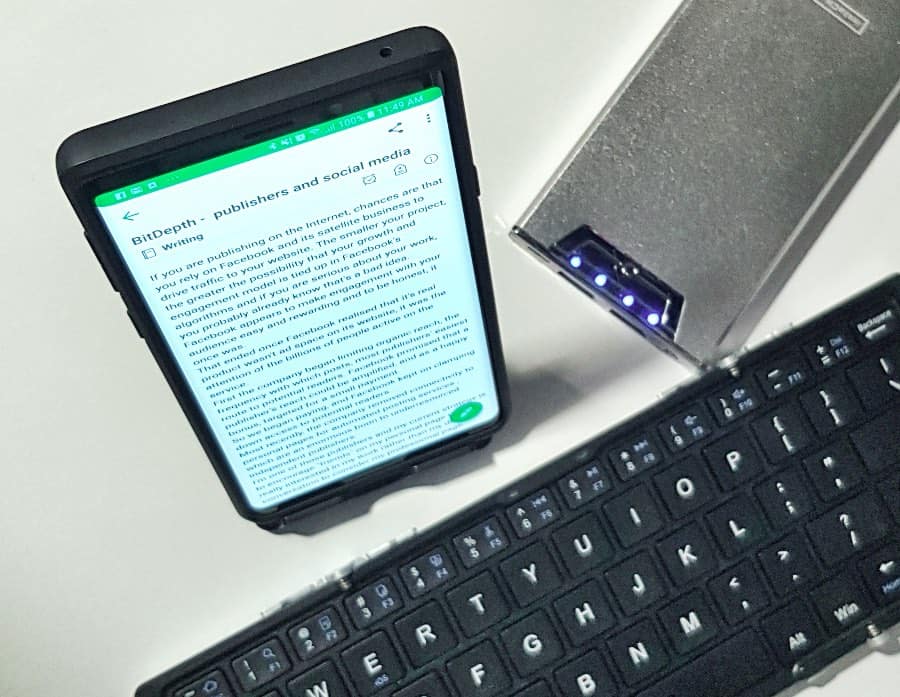
Above: My reporting kit for some assignments has shrunk to the Note9 with a foldable Bluetooth keyboard and an external high-capacity battery for longer events. Photo by Mark Lyndersay.
BitDepth#1175 for December 13, 2018
Over the last thirteen years, I’ve done more reporting from remote locations than I did in the 30 years before 2015 put together. All of it has been about technology, its devices, systems, and platforms. In that time, the expectation of time to market for tech news has been steadily compressing.
There’s probably nothing more immediate than a livestream or live-blog of an event, but that’s more like broadcasting and transcription without the additional layer of interpretation and key message selection that’s at the heart of all reporting and tech reports particularly.
If you think that’s difficult, try factoring in all the gear you have to carry along to actually do that work effectively.
Early in this game, my reporting bag clocked in at more than 25 pounds, with a laptop, DSLR, lenses and a host of cables, including chargers, and transfer cables.
For a couple of years, I did near-live reporting with an iPad with a keyboard cover from Logitech which was excellent, but by then I was getting really tired of the load, which was close to half of my overall travel weight.
I briefly considered getting an ancillary lightweight laptop, like a Macbook Air, but dividing my work across mutliple computers never seemed like a great idea to me.
Over the last 18 months, I’ve been drifting ever closer to relying completely on the increasing capabilities of modern smartphones for my reporting, which, for breaking news, is often filed before I leave an event.
The Note9 brings some useful mojo to the smartphone as working tool.
Speed. The Exynos 9810 octacore processor in my test device does an excellent job of handing off workload and after pushing the device with entirely too many apps and windows open, I’ve never experienced a lag or hesitation in day to day use.
Battery life. Live reporting with a smartphone puts a heavy drag on battery and processor. I’ve usually got all the radios on, connected to a Bluetooth keyboard, fishing for a WiFi signal and keeping mobile data on as a fall back. I do lots of app switching, sometimes grabbing the phone to snap a photo then switching back to Evernote to keep writing.
If something doubtful or confusing gets announced, I’ll usually just hit a search engine immediately instead of waiting for the Q&A and sometimes that search will make for a sharper question that needs to be asked.
Even in such demanding circumstances, you’ll get a full day’s work out of a charged Note9.
Memory. In a typical reporting environment, I’ll be switching regularly between Evernote, where I compose text, QuickPic to browse images and make preliminary selects, Lightroom Mobile to edit images and apply copyright information, the WordPress app where all the elements get assembled for publication and HootSuite, where I prep an early social media blast about the reporting.
The Note9 manages all this comfortably with 6GB of RAM. My next step is to start working with video clips captured in the smartphone environment, because breaking hardware is every techie’s dream.
Samsung has built their desktop experience software, DeX, directly into the Note9, and while the company would absolutely prefer that you use their cables and devices, I found them both too much and too little for my needs.
The DeX cradles are too much device for my needs while the DEX cable only connects to HDMI, and I needed VGA for occasional projector connections.
CableCreation’s adapter offers both ports and with some trepidation, jacked the smartphone into the Samsung 34-inch monitor that’s hooked up to my workstation.
I switched monitor input ports and the Note9 asked whether I wanted to mirror the screen or use DeX after warning balefully that I should use original Samsung cables. I tested both modes, and really, you have to experience DeX to get it.
I put a web page next to Evernote for multitasking, and the screen didn’t feel crowded.
I’m not quite sure how Samsung manages it, but there’s no lag or refresh issues on a device that’s smaller than most high-powered video cards.
My test unit shipped with the Mali G72 graphics processor, most US and LatAm units ship with the Qualcomm SDM845 Snapdragon CPU and the Adreno 630 GPU a GPU architecture originally developed by ATI/AMD under the Imageon brand.
Plan to add a Bluetooth mouse though, because using the smartphone’s screen as a trackpad isn’t optimal. It works, but the Note9’s screen surface is too smooth for efficient cursor tracking. I did not find the stylus to be an improvement over using my finger.
There’s an increased drain on the battery while in this mode, so anyone doing this for longer than a couple of hours, perhaps to work on spreadsheets, multitask or develop a presentation, should consider Samsung’s multiport adapter, which charges the device and adds ethernet and a standard USB port.
I like the smaller adapter because I never use the televisions in hotel rooms and this would repurpose them nicely as a large monitor on location.
I’ll probably still keep travelling with a full laptop, but the Note9 effectively replaces a tablet for work and is an excellent tool for spot reporting on its own.
Journalists really should keep an eye on this device space, because these tools are striking out determinedly in the direction of all-purpose mobility devices. I certainly appreciate the weight loss in my carry-on.



